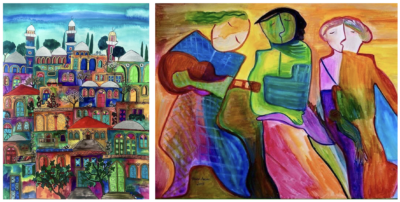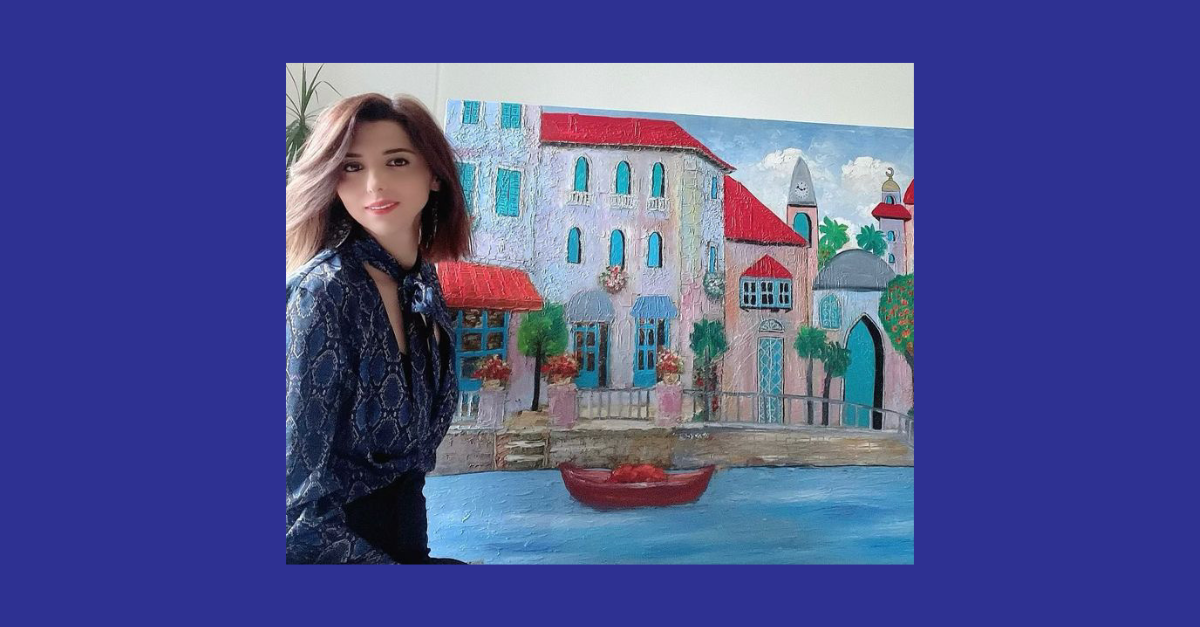Rawan Anani is a Palestinian watercolour artist. Her work focuses on representing Palestinian heritage through its cities, culture and women. During an interview on a sunny afternoon, she walked me through her colourful and surreal world, full of bright optimism.
The background
“I lived and grew up in Al-Bireh city in Ramallah from an artistic family. I have two daughters and I am currently living in Beirut. I love life, and my work will show you my personality. I am a very optimistic and cheerful person. I’m bold and reckless at times! I’m known for the warm, bright colours that are attractive to the eye. My passion is painting, as it is an essential part of my life. I must paint every day, for about three to four hours. If I don’t, I feel that there is something missing in my life.

Al Bireh (2023), Love & Harmony (first watercolour artwork, 2015) – © Rawan Anani
When I first started painting, it was on canvas with acrylic, not watercolours. I remember exhibiting at my brother’s gallery and thinking that I should take another path, try other colours: watercolour on paper, so I started. My personality is like watercolour, they’re bright, so I thought I’m more into watercolour than acrylic!”
The main characters: Nabil and Siham Anani
“Among my sisters, I am the only one who became an artist. Honestly, I never dreamed of being an artist. I studied something else and worked for a while. Then I got married and went to Saudi Arabia. My daughters got older and went to school, so I had free time. My parents encouraged me to go into art. My father helped me, gave me his perspective, his remarks, and made me grow. During the first and second intifada, I remember, we were always at his studio. We stayed with him there and watched him paint. In his paintings he uses materials: he puts copper, wood, straw, and even spices in his paintings!
Motherhood (1995), Palestinian icon (2015), In pursuit of utopia (2020) – © Nabil Anani
My mother is also an artist and had great impact on me. She used to paint when she was young and had paintings at my late uncle’s house. Her name is Siham. Her paintings are both sweet and difficult: she painted things related to snow and nature.”
Palestinian cities
“I love drawing Palestinian cities. When I started in 2013, no one painted these cities, such as Qalqilya or Halhul. I wanted to embrace this topic and started painting, but in a different way, not realistically.

Jerusalem (2017), Haifa (2016), Ramallah (2019) – © Rawan Anani
I paint some of them from imagination, such as Al-Bireh and Ramallah. For the rest, I search on Google. I have different styles. I drew Jerusalem in a straight way, but for others, there are overlapping houses so that you can make a little movement in the painting, as if there were an earthquake! You feel that there is something in the painting that attracts you more than the colours.”
Medallions
“This is another way to depict cities. I invented the concept, it occurred to me: why don’t I change and paint them in a circle? The first thing I thought about was the olive tree, which is a great symbol for us in Palestine. Then I started to diversify: for each city, I placed all the important landmarks inside the circle, and also started with women.

Nablus (2018), Ramla (2018), Al Quds (2021) – © Rawan Anani
People love these medallions very much and they like to hang three paintings from different cities next to one another. I started quoting Mahmoud Darwish’s poetry. At the same time, it is enhanced through colours. The background is dark, the colours are clear and the city centre is colourful, a new style!”
Palestinian women
“On social media, I always get asked: why do women have no facial features? Why do you draw women? Where are we, the men? I think women are an aesthetic element in the painting: the embroidered Palestinian dress has very beautiful colours and geometric patterns. This gives an aesthetic addition to the painting. I consider women to be the most important part of Palestinian heritage. Men’s traditional outfit does not have much!

Women of Gaza (2018), Windows Ramallah (2020) – © Rawan Anani
Regarding the facial features, there is no specific reason. I’m trying to simplify the shape with the absence of features. This has become my artistic identity, which I am very proud of.
Palestine is my inspiration. I feel very connected to my country when I paint it. Even the occupied Northern Palestinian cities I visited when I was little live in my memory. I paint them more than the cities in the West Bank: the sea and beautiful nature of Haifa and Jaffa. Gaza, of course, which I visited it when I was little.

Making & eating musakhan, Ramallah (2023), Women in the fields, Tulkarem (2021) – © Rawan Anani
I love to paint everything that has a link to heritage, even musakhan (editor’s note: traditional Palestinian dish made of roast chicken, heavily scented with sumac and other spices, served with caramelised onion flatbread)! Also the olive tree, a symbol of steadfastness, the fig tree and vines.”
May Rawan Anani’s playfulness and optimism help us see our own homeland with the same sense of awe!
This interview has been edited for length and clarity.
Cover picture: The artist in her studio with the artwork Jaffa 2023 © Rawan Anani
Find out more Instagram: @rawan_anani_artgallery Website: www.facebook.com/rawananani.net Watch the video interview: https://www.youtube.com/watch?v=huzC-zgLSMs

